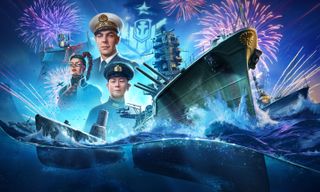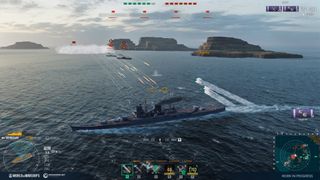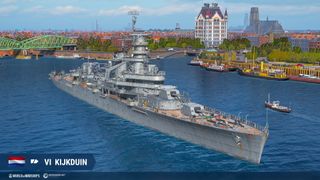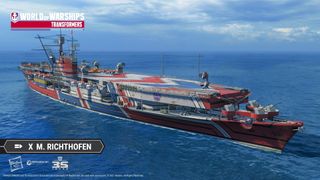World of Warships producer talks six years of high seas brawling
Executive Producer Philip Molodkovets talks naval warfare to celebrate WOW's sixth birthday.

Since its launch in 2015, World of Warships has gathered over 44,000,000 players from all around the world. They are the captains of darting destroyers launching devastating torpedo attacks; they command cruisers and battleships, firing thundering broadsides at their distant foes. And they stand over the flight decks of mighty aircraft carriers and squadrons of fighters and bombers. The game came out of beta into the light of day six years ago, and a lot of the game’s base systems have seen some degree of update or overhaul in that time; carriers in particular went through some massive changes a few years back, and now another great change is about to rock the boat.
I was lucky enough to be invited to preview the submarine expansion in Tokyo back in 2018, but getting the balance right for these sneaky sub-surface ship-killers has been quite the task, and they’re only now getting fully released into the game.
But that’s just the latest change. At launch World of Warships featured a limited number of ships from the five big powers of World War 2, but there are now 11 nations in total, fielding over 400 warships. When work on World of Warships began, the studio working on it (then called Lesta Studio, but now officially Wargaming Saint Petersburg) were only 40 staff, but now 500 people work on the game, delivering monthly content and updates.
And in that time, the game’s followed in the footsteps of its land-based sibling, World of Tanks, and has raised hundreds of thousands of dollars for veteran support and charities. Similarly, Wargaming has teamed with a raft museums and preservation efforts; the company raised nearly US$50,000 towards the restoration of the USS Batfish (a Balao-class submarine that famously sank three Japanese submarines in a single 76-hour period on her sixth war patrol) and the USS Texas (a battleship that supported the D-Day landings before transferring to the Pacific theatre for the rest of the war).
To celebrate the date, World of Warships has received a massive content update today. Not only do the Dutch arrive on the unfriendly seas, with a range of cruisers for all tiers, the Russian’s get three new early access carriers—the Tier IV Komsomolets, Tier VI Serov, and Tier VIII Pobeda, all hitting early access, via tokens earned in-game. Both sets of ships feature unique new airborne capabilities. There’s also a new type of mission to play, inspired by the massive escort convoys that ultimately helped the allies win WW2. In the mission, players must either defend or destroy a convoy of four AI ships.
There’s a host of birthday activities and loot to collect, and Wargaming’s even teamed up with another franchise celebrating a big milestone—Transformers. It’s 35 years since the release of The Transformers: The Movie, and four Transformers are now available to captain your warships, and you can find all manner of Robots in Disguise swag. Autobots... sail out!
To say that it’s been a busy six years is a bit of an understatement, so we're happy to have the time to catch up with the game’s executive producer, Philip Molodkovets, to talk about the game’s evolution, and its future.
The biggest gaming news, reviews and hardware deals
Keep up to date with the most important stories and the best deals, as picked by the PC Gamer team.

PC Gamer: I know that the St. Petersburg team has grown a LOT in the last six years —were you there when it was just 40 people? What was it like in those early days, and how does it feel now that you have a much larger team, and space to work in (I saw your offices for the ‘new’ carrier preview a few years back, and I can remember it had some space set aside for expansion!).
Philip Molodkovets: I joined the World of Warships team somewhere between internal testing and Closed Alpha, so even if it was not exactly 40 people, it sounds about right. It was also the first job in the industry for me (as Community Manager), so overall, looking back, I see a lot of changes and growth—in the game itself, us as a team, and as a studio. It has been quite a ride! I feel very lucky to be a part of the game and our community. As for the studio, it’s not even about the office size, it’s about what we’ve become. Today about 800 people work here on several games on several platforms. It is bigger than World of Warships now, but World of Warships is still our flagship game, and I’m sure it will always remain special for us. What’s very important to me personally, this growth did not kill our work culture and identity: people here are still engaged and open-minded. We still can freely discuss and solve issues, bring new ideas, and shape the future of the game together.
It still feels like people doing what they actually love and care for. I hope this spirit will never change.
Speaking of previews, I was also at the submarine preview event in Tokyo—which was three years ago now! I understand that submarines are still being tweaked and fine-tuned; can you give me an idea of how that system has evolved since then?
It has evolved a lot, to put it mildly. We’ve started from the Halloween 2018 event, and since then we’ve had six open test iterations, one of which was conducted on our main server as a special game mode. We analysed the feedback after each test and implemented a lot of changes, from minor tweaks to big overhauls of some core parts of submarine and anti-submarine gameplay.
For example, we needed something to be a limiting factor, so that a submarine will have to surface sooner or later. We started with a limited amount of oxygen, which could slowly recover on the surface. Then we switched to a battery charge, which was needed to fully unleash your submarine’s attack capabilities; but depleting it didn’t lead to emergency surfacing. There were several other steps in this process, but eventually we’ve ended up with the concept of a bit more abstract parameter – dive capacity. It unifies not only air reserve and battery charge, but overall each submarine’s parameters and systems engaged in underwater “hunting”, and also may be slowly recharged on the surface.
Another example would be anti-submarine warfare (ASW) tools. We started with destroyers and some other ships having depth charges, which are useful against submarines only if you get very close. But we’ve added an airstrike that can be called by some battleships. Also, detecting a submarine while they are submerged makes them lose dive capacity quicker; thus even ships without strong ASW armament have some tools against subs.
Now we’re approaching the biggest step so far for the new class, a prolonged gaming period on the main server in two types of battle: Cooperative against bots and Ranked in PvP. This will allow everyone to try out the most recent changes and share their feedback. It’s cool that you saw one of the oldest versions, so I encourage you to try this one—I think you will find how much certain things have changed rather amusing.

Given the ongoing addition of new ships to the game, how has that game design process changed over the years? Has it become more streamlined?
Indeed. Obviously the technical side of it has seen a lot of improvements—I’m talking about things like visuals and armor modelling. Gameplay and balance wise, we’ve created a lot of new tools and metrics to evaluate ship performance both in combat and in terms of players’ satisfaction. We take a lot more factors into account now—basically, everything that players or testers do in battle is in some way logged and taken into our statistical tools.
However, all this experience and assets are in very high demand, too, because our job has become much more difficult. With hundreds of ships in the game and dozens being added, we need to explore more opportunities to bring something interesting and fresh, and at the same time it’s more challenging to keep the system in good health and balanced. So I’d say that streamlining and evolving of the game design process for us is not just an option—it’s a hard requirement.
What would you say are some of the most important lessons about the game that you or your team have learned over the last six years? Is there anything you wish you knew then that you know now?
The game will stay in active development for years and you will see not just more ships and maps, you will see new gameplay, new experiences, and new visuals
Anyone would be happy to know how to avoid mistakes, and obviously, we’ve had a share of mistakes over the years. But unfortunately, some lessons can only be learned the hard way. Some of the most important lessons are connected with how to provide quality entertainment in the game, how to communicate and inform our players about our plans, how to change things we believe are to be changed, and how to balance your own opinion, player feedback and data when making decisions. How to handle difficult situations—this topic is too huge to cover in any kind of interview in detail.
The progress is amazing, but what’s most important, it does not mean we should stop. We need to stay open minded and be ready to change in future. It’s more about the general attitude than about a couple of specific important lessons.
Have you seen Covid-19 have any kind of an impact on player habits? And has it impacted the St Petersburg office at all? I’m currently writing these questions from home!
We worked from home, too, for a while. But I think it was just several months, when the situation was really bad. We’ve been working in the office normally for the most part of the pandemic, but surely things changed for us: masks, air purifiers, sanitisers, distancing, regular tests and checks—a lot of measures were taken to make our office safe. And it worked!
We also have a very good percentage of vaccinated colleagues her—approaching 70%, I believe. I know it won’t happen right away, but surely we all want this pandemic to end, finally. It’s very important for our work culture to be in the studio together, to have ‘offline’, face-to-face communications. So as long as it’s safe and allowed by local regulations, we will be working from the office.
As for the player habits, people were often forced to stay home and it inevitably affected their online activity. We did our best to provide them with good online entertainment; after all, playing video games was one of the rare ways to actually have fun with friends or forget about the pressing issues in the world for a while. We don’t relax over that, because when the pandemic ends, habits may change. Who knows, maybe people will be too hungry for offline activities to play games, at least for some time. Our plan is very simple here: to keep working as hard as we can.

What has been the one part or aspect of the game that has been your favourite over the last few years?
Brawling. I’m not too tactical and careful when I play World of Warships. Even though it often isn’t the most efficient way, nothing stops me from rushing in guns blazing, and you know, sometimes it works as intended! Sometimes it does not, but I try not to be too mad about it. Brawling – and I mean close quarter combat – in our game is thrilling, because the stakes are very high. It’s easy to deal a lot of damage quickly, but it’s also easy to get sunk. A good brawl of course should start in the right time and place, so the game is still strategically demanding if you play it this way.
What does the next six years of World of Warships look like?
They look pretty optimistic. The game is in good health and kicking even though we will be celebrating our six-year anniversary soon. I am absolutely sure that a lot of big new things will happen; the game will stay in active development for years and you will see not just more ships and maps, you will see new gameplay, new experiences, and new visuals. Our backlog is not something to share publicly, but I’m not even sure six years will be enough to implement everything from it as of now!
Most Popular


